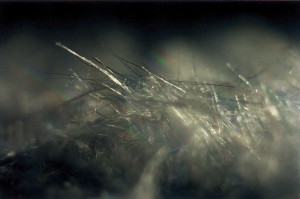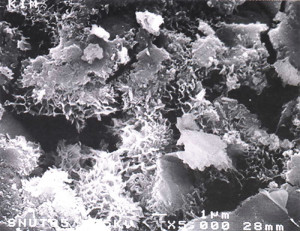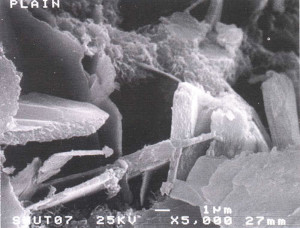The Future of Concrete Durability
In a building landscape where the expected lifespan of a structure is longer than usual, the durability of the materials that encompass the structure become more critical. Sustainability is key for any structures viability in today’s construction world, which means new technologies are of great value to not only the project teams, but also the environment.
Concrete is currently the most used human-made material in the world, used twice as much as all other materials combined. Concrete is used so much because it has a relative low cost, is versatile, has unique engineering properties and its ingredients are widely available. This often makes concrete more attractive to the construction industry than other materials like steel or wood. Moreover, a key advantage to concrete is that it can be molded or formed into virtually any shape when freshly mixed and, when hardened, becomes a strong and durable material capable of a long lifespan.

When reacting with water and cement, an ICW creates millions of needle-like crystals that block the ingress of water. Courtesy of Kryton International Inc.
In most instances, deterioration of concrete is due to a lack of adequate durability, rather than deficient strength. Concrete structures can become unserviceable due to gradual weakening arising from concrete deterioration and steel corrosion. Reducing concrete deterioration by increasing its durability has become a challenging problem facing the industry.
In most every case of concrete degradation, the root cause of the issue is the presence of moisture or water within the concrete. The ingress of deleterious substances into concrete takes place through the pore system in the concrete matrix, or through micro-cracks. In order to effectively ensure a concrete structure’s durability, which leads to a longer lifespan and a more sustainable building, the concrete must first be effectively waterproofed.
Surface Applied Membranes
As is the case in business, there are often several options to choose from; concrete waterproofing is no different. One of the options available on the market is an external surface-applied membrane. The membrane is installed after concrete has hardened to prevent the ingress of water into basements, foundations, walls, and roofs. However, surface applied waterproofing membranes do have limitations:
- are at risk to puncture damage;
- application takes time and is labor intensive;
- lifespan of the membrane is usually less than desired structure life; and
- is difficult to repair since it can be inaccessible and hard to locate the failed area.
External membrane failure can occur in a number of different situations, most as a result of design errors, installation mistakes, or material limitations and defects. This is why simplifying the process by making the concrete itself serve as the waterproofing barrier can prove valuable for a project.
Integral Crystalline Waterproofing
Integral Crystalline Waterproofing (ICW) prevents the movement of water through the concrete by plugging or blocking the natural pores, capillaries and micro cracks, thereby making concrete its own waterproofing barrier. This stands in contrast to more conventional means of waterproofing, which usually involves applying a coating or membrane to the concrete surface. The process is sometimes also attempted through densification of the concrete. The ICW method of concrete waterproofing has been proven effective through successful use in virtually every country in the world.

Concrete pores with ICW. Using an ICW improves the matrix of a concrete mix, blocking the flow of moisture. Courtesy of the University of Seoul.
The Science
ICW technology is based on principles that are very similar to the processes that occur during concrete hydration.
When ICW products are added or applied to concrete, crystalline chemicals facilitate a reaction that causes long, narrow crystals to form, filling the pores, capillaries and hairline cracks of the concrete mass. As long as moisture remains present, crystals continue to grow throughout the concrete. Once the concrete has dried, the crystalline chemicals sit dormant until another dose of water (such as through a new crack) causes the chemical reaction known as crystallization to begin again.
The ability to reactivate in the presence of water gives crystalline-treated concrete the ability to improve self-sealing. When cracks form due to drying shrinkage, settling, seismic activity, etc., water entering through them causes new crystals to form and grow, blocking and filling the cracks. Improving the self-sealing ability of concrete is one of crystalline technology’s most unique and useful features, and can help to dramatically reduce the long-term maintenance and repair costs of a concrete structure.
Main Benefits of ICW
ICW contributes many beneficial properties to a given project, including:
- Continual Protection – One of the unique traits of an ICW admixture is its ability to improve the self-sealing ability of concrete. Due to the potency of the crystalline chemicals, only a small portion is required to facilitate a large amount of crystal growth. The chemicals lay dormant so when future cracks occur, triggering new crystal growth that seals the crack;
- Easy To Apply – ICW comes in a powder form and is conveniently and easily added to new concrete at the time of batching, either in a ready-mix truck or at the plant. The chemicals create a powerful water barrier, which leaves no need for any surface applied product at the jobsite;
- Sustainable & Reliable – ICW is a permanent solution to concrete waterproofing needs. It is impervious to physical damage or deterioration, and can reduce shrinkage cracking. It’s non-toxic, safe for use in portable water and contains no volatile organic compounds (VOCs); and
- Saves time & Money – The use of an ICW admixture can accelerate a project’s schedule by eliminating the need for a traditional surface applied membrane. Backfilling can begin right after concrete has set, lowering the cost of labor and materials. ICW can also be used with structural shotcrete.
Where Can ICW Be Used
ICW systems have been used in a wide variety of concrete structures across the world. The most common applications include:
- Below-grade foundations, parking garages, elevator pits, basements;
- Bridges & dams;
- Tunnels & pipelines;
- Water containment & Aquatic facilities; and
- Marine Structures.
ICW has proven to be most effective in areas exposed to high-hydrostatic pressure, such as is found in below-grade foundations and water containment tanks.
What ICW to use?
A number of companies offer integral waterproofing products for new and existing concrete structures. These products have different chemistries and, more importantly, different levels of performance. When selecting Integral Crystalline Waterproofing products, it is important not to confuse them with:
- Hydrophobic or water repellent products; such as, water repellent soaps, fatty acids (stearates), mineral oils etc.;
- Finely divided solids known as densifiers intended to “take up space” and densify the concrete; and
- Products based on silicates, clays, bentonite, silica or polymers; these offer temporary waterproofing at best.
These products are suitable for damproofing or above grade water repellency, but not suitable for below grade waterproofing applications.
An ideal concrete waterproofing system should:
- Reduce the permeability;
- Reduce the chance of cracking; and
- Improve Self-Sealing ability.
Furthermore, the concrete waterproofing industry redefined their terminology a short time ago. In fact, American Concrete Institute’s (ACI) 212.3R-10 Report on Chemical Admixture document devoted Chapter 15 to Permeability Reducing Admixtures that outlines PRAH and PRAN classifications. Permeability Reducing Admixture – Hydrostatic Conditions or PRAH products are sufficiently able to resist water under hydrostatic pressure penetration and are suitable for watertight construction.
Conversely, damproofing admixtures are now referred to as Permeability Reducing Admixture – Non-Hydrostatic Conditions or PRAN. PRAN admixtures reduce water absorption by repellent chemicals (soap, oils) or partial pore blocking (densifiers). These admixtures are not suitable for concrete exposed to water under pressure and cannot protect in the presence of hydrostatic pressure. Waterproofing against hydrostatic pressure is an important distinction that sets PRAHs apart from PRANs.
Also, select a crystalline waterproofing supplier who can demonstrate a repeated history of long term success. The manufacturer should offer a long term warranty and have the company history to back it. The manufacturer should be able to provide accredited third party test results and have achieved industry recognized certifications for product quality and performance.
Most importantly, because of the ongoing value of close technical support, be sure to select a product from a manufacturer who has demonstrated the willingness and ability to provide on-site service and support for major projects anywhere in the world.
Conclusion
Integral Crystalline Waterproofing is the future of concrete waterproofing worldwide. With sustainable building practices increasing in importance, and the lifespan of a structure intrinsically connected to this movement, a reliable waterproofing solution that will last for the intended life of the concrete structures becomes very important.▪
References
World Business Council for Sustainable Development (WBCSD), The Cement Sustainability Initiative – Recycling Concrete, www.wbcsdcement.org.
Zhang, F.H. Wittmann, T. Zhao, and E.H. Lehmann, “Neutron imaging of water penetration into cracked steel reinforced concrete,” in Physica B, Volume 405.
L. Connell and K. Yuers, “Waterproofing Made Crystal Clear”, November 2009 issue of The Construction Specifier. (Go to www.constructionspecifier.com and select ‘Archives.’)
For more see ACI 212.3R-10 – Report on Chemical Admixtures for Concrete; 2010.

